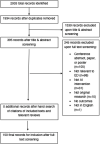Artificial intelligence in emergency medicine: A scoping review
- PMID: 33392578
- PMCID: PMC7771825
- DOI: 10.1002/emp2.12277
Artificial intelligence in emergency medicine: A scoping review
Abstract
Introduction: Despite the growing investment in and adoption of artificial intelligence (AI) in medicine, the applications of AI in an emergency setting remain unclear. This scoping review seeks to identify available literature regarding the applications of AI in emergency medicine.
Methods: The scoping review was conducted according to Preferred Reporting Items for Systematic Reviews and Meta-Analyses (PRISMA) guidelines for scoping reviews using Medline-OVID, EMBASE, CINAHL, and IEEE, with a double screening and extraction process. The search included articles published until February 28, 2020. Articles were excluded if they did not self-classify as studying an AI intervention, were not relevant to the emergency department (ED), or did not report outcomes or evaluation.
Results: Of the 1483 original database citations, 395 were eligible for full-text evaluation. Of these articles, a total of 150 were included in the scoping review. The majority of included studies were retrospective in nature (n = 124, 82.7%), with only 3 (2.0%) prospective controlled trials. We found 37 (24.7%) interventions aimed at improving diagnosis within the ED. Among the 150 studies, 19 (12.7%) focused on diagnostic imaging within the ED. A total of 16 (10.7%) studies were conducted in the out-of-hospital environment (eg, emergency medical services, paramedics) with the remainder occurring either in the ED or the trauma bay. Of the 24 (16%) studies that had human comparators, there were 12 (8%) studies in which AI interventions outperformed clinicians in at least 1 measured outcome.
Conclusion: AI-related research is rapidly increasing in emergency medicine. There are several promising AI interventions that can improve emergency care, particularly for acute radiographic imaging and prediction-based diagnoses. Higher quality evidence is needed to further assess both short- and long-term clinical outcomes.
Keywords: algorithm; artificial intelligence; artificial neural networks; emergency department; emergency medicine; machine learning; technology.
© 2020 The Authors. JACEP Open published by Wiley Periodicals LLC on behalf of the American College of Emergency Physicians.
Conflict of interest statement
The authors have no conflicts of interest to disclose.
Figures




References
-
- Topol EJ. High‐performance medicine: the convergence of human and artificial intelligence. Nature Med. 2019;25(1):44. - PubMed
-
- Beam AL, Kohane IS. Translating artificial intelligence into clinical care. JAMA. 2016;316(22):2368‐2369. - PubMed
-
- Hamet P, Tremblay J. Artificial intelligence in medicine. Metabolism. 2017;69:S36‐S40. - PubMed
-
- Jha S, Topol EJ. Information and artificial intelligence. J Am Coll Radiol. 2018;15(3):509‐511. - PubMed
-
- Krittanawong C. The rise of artificial intelligence and the uncertain future for physicians. Eur J Intern Med. 2018;48:e13‐e14. - PubMed
Publication types
LinkOut - more resources
Full Text Sources
